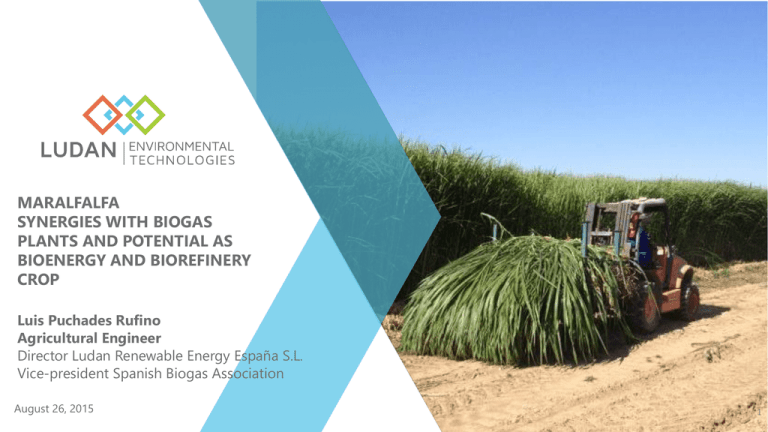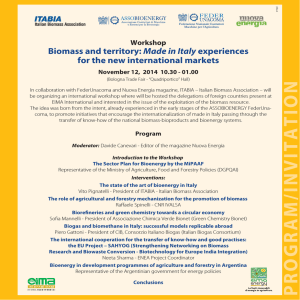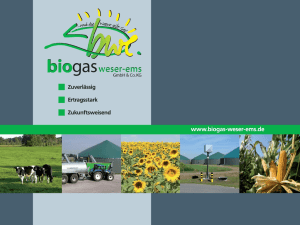Productivity (t DM/ha)
advertisement

MARALFALFA SYNERGIES WITH BIOGAS PLANTS AND POTENTIAL AS BIOENERGY AND BIOREFINERY CROP Luis Puchades Rufino Agricultural Engineer Director Ludan Renewable Energy España S.L. Vice-president Spanish Biogas Association August 26, 2015 1 MARALFALFA DESCRIPTION Maralfalfa (Pennisetum spp.) is a crop originated in South America, with different theories about its origin. It is not a GMO. It belongs to the Pennisetum genus, from the Poaceae family. Pennisetum is a widespread genus of plants in the grass family, native to tropical and warm temperate regions of the world. Maralfalfa is a fast growing grass, being considered one of the promising feed grasses of the world. 2 MARALFALFA DESCRIPTION In several countries, it is being implemented the use of tropical grasses related to the Elephant Grass (Pennisetum purpureum (Schum)), that have the characteristics of having an extraordinary potential of biomass generation. Amongst them can be found Taiwan, King Grass, Napier, or the recently introduced OM-22, CT-115 and Maralfalfa. Such cultivars of P. purpureum are widely used in the tropics, but there is also an important lack of scientific studies about its bioenergy potential, especially in the areas of bioethanol and biogas. Our results show that the crop has the potential to become of the most popular energy crops in the world, as can overproduce most of the most popular energy crops worldwide: corn, sorghum, beet and sugar cane. 3 MARALFALFA DESCRIPTION Ludan has been developing over the last years a detailed study in Maralfalfa and other Pennisetum cultivars implemented in Spain, with the following objectives: 1. Define its productivity and adaptation in Spain. 2. Check the resistance to cold weather. Winter survival 3. Check on a technical levels the costs of cultivations 4. Define the potential of the crop as energy crop 5. Study the synergies in the use of the digestates of the existing biogas plants 6. Evaluate the overall economical and environmental sustainability of the crop 4 BIOMASS PRODUCTIVITY 5 It is important to define that the biomass productivity of a certain crop depends not only on its genetic potential, but also from the external inputs. The amount of environmental resources will determine the productivity of pastures and crops (Valentine I, Mathew C, 1.999). Therefore, the comparison shown below has only limited value, as the results are taken from different places under different cultivation processes. Crop Maize silage Maize silage Sorghum silage Sorghum grain Fodder Beet. Mammoth Long Red Fodder Beet. Red Globe Sugar Beet. Shepard Sugar Beet. White Klein Maralfalfa Productivit y (t Reference DM/ha) 33,50% 25,00 Pioneer cathalogue 34,70% 20,82 University of Tennessee 28,9% 24,36 INTA Paraná 34,6% 19,47 INTA Paraná Productivit Dry matter y (t FM/ha) content 74,63 60,00 84,32 56,22 95,70 14% 13,40 83,39 54,50 38,64 235,00 14,50% 22,50% 24,60% 19,30% 12,09 12,26 9,51 45,30 Washington State University Washington State University Washington State University Washington State University Own research BIOMASS PRODUCTIVITY 6 Productivity (t DM/ha) Up to 30% more potential without winter 50.00 45.00 40.00 35.00 30.00 25.00 20.00 15.00 10.00 5.00 0.00 Maize silage Maize silage Sorghum silage Sorghum grain Fodder Beet. Fodder Beet. Sugar Beet. Mammoth Red Globe Shepard Long Red Sugar Beet. White Klein Maralfalfa BIOMASS PRODUCTIVITY Keys for success: • Regrown • Development of radicular systems. Winter survival • Plagues relative resistance • Rusticity • Efficiency in the absorption of nutrients • Temperature 7 TESTS IN EXTREMADURA Sorghum. 8 Maralfalfa Tests held in Extremadura during 2014, combinig Maralfalfa, corn and sorghum. Corn. TESTS IN EXTREMADURA Duration Fertilization Irrigation Rainfall during period Crop Sorghum Corn Maralfalfa April 2014 - November 2014 250 kg N per hectare (150 kg Urea, 52 tons of digestate) 6.000 m3 water per hectare 425 mm Productivity Dry matter Productivity Harvests (t FM/ha) content (t DM/ha) 85,80 29,40% 25,23 1 65,40 34,70% 22,69 1 235,30 19,3% 45,30 2 Tests held in Extremadura during 2014, combinig Maralfalfa, corn and sorghum. 9 TESTS IN OTHER PARTS OF SPAIN Planting frame Place Vall d´Uixó Los Alcázares Vall d´Uixó (Castellón) Los Alcázares (Murcia) Two canes parallel. 75 cm between rows Nitrogen fertlization (kg N/ha) Date 80 170 350 15th August 18,1 22,5 25,1 1st december 19,3 21,3 27,4 15th August 16,3 21,8 24,1 1st december 19,4 23,5 24,5 Biomass generation (tDM/ha) Place 10 30 25 20 15 10 5 0 80 170 Fertilization (N/ha) 350 BIOGAS PRODUCTION TESTS The batch test is a discontinuous test in which organic substrates or co-substrates are subjected to fermentation under defined anaerobic conditions. Maralfalfa is suitable for biogas production, just like most vegetables. The biogas production is around 570 l of biogas per kg of VS, with a methane content around 60%. 11 BIOGAS PRODUCTION TESTS Parameter Loading Reactor volume Daily input Retention time Organic load Fermenter output Dry Matter Loss on ignition Organic Dry Matter Ph Organic acids Ammonium-N Dimensions l Kg/d d Kg oDM/m3d % % DM % mg/l mg/l Mesophilic 5,48 1,4 39,2 5,98 12,96 71,42 9,23 7,51 1.144 1.380 12 Parameter Biogas Gas production Gas yield Gas yield Methane content Methane yield oDM Dimensions Mesophilic mn3/(m3d) mn3/kg oDM mn3/kg FM Vol % mn3 CH4/kg oDM 3,422 0,577 0,132 56,900 328 CONCLUSIONS ON BIOENERGY POTENTIAL 13 Combining the biomass yields with the biogas potential, it can be seen that Maralfalfa has very interesting possibilities as bioenergy crop. The results obtained for biogas probably can be obtained similarly with ethanol, as they are both biological anaerobic digestions. Up to 30% more potential without winter Biogas production (Nm3/ha) 25,000 20,000 15,000 10,000 5,000 0 Maize silage Sorghum silage Fodder Beet Sugar beet Maralfalfa INTEGRATION WITH BIOGAS SYSTEMS It has been reported that one of the main limitations of the production of grasses is the availability of nutrients. Large biomass productions tend to extract enormous amounts of nutrients and organic matter from the soil. Taking Maralfalfa as reference, a production of 200 tons per hectare, with 18% DM and protein content of 14%, will lead a production of 5 tons of CP per hectare. Using a protein factor of 6.25 (CP/Total Nitrogen), shows an extraction of 800 kg of Nitrogen per hectare. Therefore Nitrogen availability becomes one of the main limiting factors to sustain large biomass productions, especially on the long term. 14 INTEGRATION WITH BIOGAS SYSTEMS Organic input material such crop wastes, foodstuff remnants, sludge from food industries, slaughterhouse wastes and manure are fed into the biogas plant digester. All those products are quite rich in nitrogen. The anaerobic digestion process generates a substance called digestates comprised of water + organic matter + nutrients. These digestates serve as plant fertilizer enhancing plant growth, as they provide nutrients, organic matter and other benefits. 15 INTEGRATION WITH BIOGAS SYSTEMS 16 INTEGRATION WITH BIOGAS SYSTEMS 17 BIOREFINERY CONCEPT The production of energy and food/feed based products from the same raw materials, or in the same installation, is one of the keys of success of the industry. The characteristics of Marafalfa crop make it an ideal candidate for this approach. Its levels of crude protein and digestibility make it a product with similar characteristics to Alfalfa. Therefore it combines a huge energy potential (production of large amounts of digestible carbohydrates) with good nutrient characteristics (digestibility, protein content). Recent studies in the Polytechnic University of Valencia (2015), using material provided by Ludan Renewable Energy, confirm this statement. 18 BIOREFINERY CONCEPT Aminogram (total AA) Valine Tryptophan Threonine Tyrosine Serine Methionine / cystine Lysine Leucine Isoleucine Histidine Glycine Phenylalanine Arginine Alanine Glutamic Acid Aspartic acid Proline Total g AA/100 g mg pasture aminoacido/ 0,17 55,56 0,05 16,34 0,11 35,95 0,1 32,68 0,17 55,56 0,06 19,61 0,14 45,75 0,18 58,82 0,1 32,68 0,07 22,88 0,12 39,22 0,14 45,75 0,14 45,75 0,15 49,02 0,3 98,04 0,94 307,19 0,12 39,22 3,06 1000 19 BIOREFINERY CONCEPT Maralfalfa is rich in all the essential aminoacids, its digestibility is acceptable and is very palatable for animals. The base of the product is very good to be used in a combine bioenergy + feed production process. There are several processes of biorefinery where Maralfalfa can have a relevant role: • Production of feed pellets from a combined CHP unit • Bioethanol production and use as DDG • Extraction of protein concentrate previous to anaerobic digestion • Advanced extraction forms 20 Thank You







